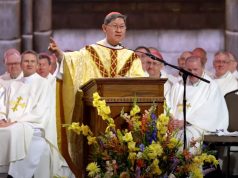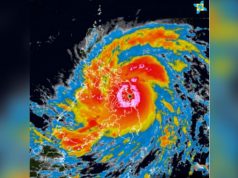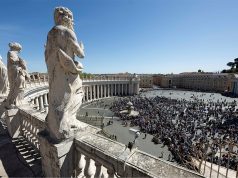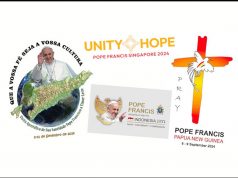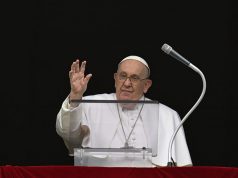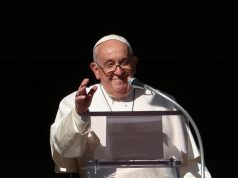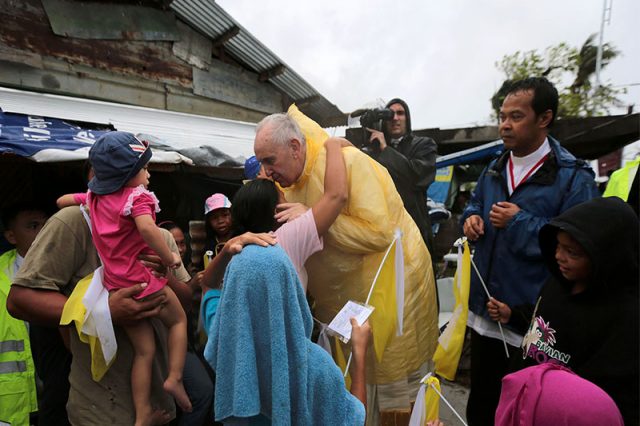
It has been a decade after the cataclysmic devastation wrought by super typhoon “Yolanda” in Kan Daya, traditional name for the Leyte-Samar area, and almost eight years after Pope Francis’ visit of utmost compassion. Many of us from this region are used to speaking of “historic landings” that impacted not only our existence in Kan Daya or the Eastern Visayas littoral but the fate of the whole nation as well.
These are the dates of the Leyte-Samar landings: March 1521 (Magellan), October 1944 (MacArthur), November 2013 (Yolanda), and January 2015 (Pope Francis). The First Landing was more than 500 years ago. Our forebears here in Kan Daya were not quite sure what impact this most surprising arrival of complete aliens would have on them and their life ways. For one thing the foreigners exhibited fire power that deafened their ears! Did they intend harm or good? For, clearly, they could do much harm. Could they also do much good? Only much later, when the Spanish colonization and subjugation of the archipelago finally got under way, would it become clear how the First Landing on Leyte Gulf had in fact led to the loss of 900 years of freedom and prosperity, and the loss of life on a grand scale in one revolt after another of a people used to freedom and self-possession.
With the Second Landing, 79 years ago, Leyte Gulf became one of the biggest cemeteries on Earth. Approximately 16,900 military people died in the Battle of Leyte Gulf. Fifteen thousand (15,000) of those casualties were Japanese, the other 1,900 were American. The battle was fought over three days in October 1944, the biggest naval battle in recorded human history. In all, this liberation of the Philippines cost the U.S. 10,400 and the Japanese over 250,000 casualties. Who knows how many residents of Leyte Gulf themselves died as “necessary collateral damage” in this Second Landing? Nobody was counting. My immediate family lost my eldest sister in the bombings. But clearly, “after the loss of Leyte, I realized that victory was impossible,” said the Japanese strategist and commander, General Yamashita.
The Third Landing, for its part, inflicted a controversial number of casualties and a razing to the ground of thousands upon thousands of homes and farms, factories, schools, hospitals and churches, of everything standing up without discrimination so that one must describe the one-sided battle that lasted no more than a few hours as cataclysmic to the max. The devastation was much worse in this Third than in the Second Landing.
Yolanda’s operation was simple. It submerged the inhabitants of Kan Daya by the hundreds and the thousands. When it left after a few near-interminable hours of black water torture Kan Daya could not immediately count how many hundreds or thousands of her inhabitants died in the deluge. The bodies of relatives and friends started showing up at the downtown area of Tacloban, at Brgy. San Fernando, Sagkahan, Marasbaras, V&G, Brgy. 88, at San Jose near the airport where a police training camp was located. In minutes, the Yolanda armada immediately took out and submerged 200 national police trainees by that airport.
At the Red Beach barangays in Palo town, at Brgy. Salvacion and especially Brgy. San Joaquin, how many inhabitants were immediately drowned as were so many of their forebears almost 70 years earlier? And, of course, so were Tanauan town’s Santa Cruz, Calogcog, Maguey, Likod, Buntay, San Roque, Sto. Nino, Cabuynan and Bislig near the well-cared for Olot and other barangays of Tolosa town.
Anyone who was familiar with these highly populated places of the coasts not just in Leyte but in all Kan Daya may be forgiven for estimating that the Yolanda armada must have immersed unto death some twenty thousand people of the whole region—at least.
The late President Benigno S. Aquino III, however, was irked, if not profoundly angered that his “zero casualty” confidence could be so grossly contradicted. The police general who honestly and competently did so in the interest of truth was summarily removed from his post. Had not Anderson Cooper and the whole universe of foreign media come to the rescue by shaming the Philippine national government for the anarchy that had set in, the consequences of the Third Landing would have been much worse. The Yolanda armada wiped out not only thousands of lives and property in the communities of Kan Daya; it wiped out before the whole world all of national government’s pretensions to efficient management and effective governance.
All was lost. Here was Ground Zero. This was Tabula Raza. It was surely time to get out of the nightmares to have new dreams for a new Kan Daya, stronger, greener, more prosperous, more intelligent, freer, more participative, and more ready to meet and withstand any number of Yolanda armadas yet to come. But this was not to be – not yet. Weeks followed each other quickly and the months rolled speedily into a little more than a year with very few dramatic instances of transformation.
Well, it’s true that Tacloban saw a plethora of brand-new motor vehicles, beautiful to behold, with beautiful people going to a few instantly organized international eating places including fine dining at its best: this was the new population of official and non-government aid-givers.
The fourth landing
Pope Alexander VI was Pope of Rome in the First Landing. His successor in the Third Landing, by the grace of God Supreme Pontiff in 2013, was very much a different kind of person – a Bergoglio, not a Borgia. He was a Jesus type. He idolized a medieval friar named Francesco d’Assisi and took this name to be his own – “Pope Francis.” Inexplicably, in less than one year of his papal reign Francis already became the most talked-about person on Earth – a planetary rock star showing everyone that all we need is love, love, love: that is all we need. This was long before today’s schism-prone extreme righteous conservative rightists got their act together to call Francis a heretic and a pseudo-Pope.
However, no less powerful than any Pope in the past, Francis nonetheless does not rule over kingdoms and empires but unabashedly seeks to usher in what Jesus styled “the Kingdom of God,” meaning the kingdom of love – in all of which he is incredibly credible.
As soon as Leyte experienced the Third Landing, Francis immediately sent out prayers and love through a tweet in his official account @Pontifex: “I ask all of you to join me in prayer for the victims of Typhoon Haiyan / Yolanda especially those in the beloved islands of the Philippines,” the Pope said. He immediately told a crowd of pilgrims, tourists and Romans in St. Peter’s Square that he wanted to assure the people of the Philippines and surrounding region that he feels close to them. He lamented the high toll of dead and the enormous damage, and then requested silent prayer for “our brothers and sisters.”
Right after his election, Pope Francis had been invited to visit the Philippines for one reason or another, and for various excuses, by the Cardinal Archbishop of Manila and by the Bishops’ Conferences. But he was noncommittal, understandably, given his newness in office and his urgent agenda items for the whole church with so limited a timeframe in each passing day.
But when Yolanda struck Leyte Gulf and Pope Francis saw the cataclysmic damage in life and the means to life, he immediately wanted to go and be with his suffering brothers and sisters. No, he did not say he wanted to visit the Philippines, not immediately. What he most wanted was to land in Leyte and embrace the victims and their loved ones – his loved ones all.
On January 17th 2015, only a little more than a year from the Third Landing, Leyte once again experienced a historic arrival. Although it had been sufficiently announced for almost a year, still when the day came there were doubts that it would happen. A moderately strong typhoon, packing 130-kilometer-per-hour winds, was not about to change course. Local church and state officials conferred with this writer as to the possibility of switching schedules for the Pope: Manila on the 17th and Leyte on the 18th—a real logistical nightmare if ever there was one. The idea remained in the realm of perpetual possibility when the writer remarked, “Tell that to the Pope!”
In the event, the Pope did land, the typhoons increased in strength, the rains refused to stop, the puddles started to become floods in many areas where almost a hundred thousand pilgrims ignored rain and wind and soaking wet shoes to hear the unbelievable Arrival speak in clearest Spanish and accurate English translation to the loud speakers across kilometers of people crying for purest joy and rediscovery of their spiritual essence.
He said: “I’d like to tell you something close to my heart. When I saw from Rome that catastrophe, I had to be here. And on those very days I decided to come here. I am here to be with you—a little bit late, but I’m here.”
I was saying to myself: this is not Magellan, this is not MacArthur, this is not Yolanda – this is the Fourth arrival, this is Pope Francis.
Francis continued: “I have come to tell you that Jesus is Lord. And he never lets us down. ‘Father,’ you might say to me, ‘I was let down because I have lost so many things, my house, and my livelihood.’ It’s true if you say that and I respect those sentiments.”
“But Jesus is there,” he continued, pointing to the cross: “nailed to the cross and from there he does not let us down. He was consecrated as Lord on that throne and there he experienced all the calamities that we experience. Jesus is Lord. And the Lord from the cross is there for you. In everything the same as us. That is why we have a Lord who cries with us and walks with us in the most difficult moments of life.”
Did anyone among the tens of thousands mind the rain and the winds? I saw none and I did look around a lot seeing so many friends and familiar faces, myself having lost so many close relatives and friends but with so many survivors I had also known, including some of my immediate family, who were all here now – all collectively thinking that this must be, this had to be, the reason why they survived, why they were given a new lease in life—to be here now.
“So many of you have lost everything. I don’t know what to say to you. But the Lord does know what to say to you. Some of you have lost part of your families. All I can do is keep silence and walk with you all with my silent heart.
“Many of you have asked the Lord – why lord? And to each of you, to your heart, Christ responds with his heart from the cross. I have no more words for you.
“Let us look to Christ. He is the lord. He understands us because he underwent all the trials that we, that you, have experienced. And beside the cross was his Mother. We are like a little child in the moments when we have so much pain and no longer understand anything. All we can do is grab hold of her hand firmly and say ‘Mommy’—like a child does when it is afraid. It is perhaps the only words we can say in difficult times—‘Mommy’.”
In joy, in pain, in tears, with the rains incessantly falling and the winds accelerating from 120 to 130 Kph, the people of Kan Daya were now experiencing this unity of being; he and they were one. They looked at Francis again and heard the fatherly-motherly-brotherly-sisterly voice caressing and penetrating the very core of one’s essential nature, comforting, strengthening, and understanding:
“Let us respect a moment of silence together and look to Christ on the cross. He understands us because he endured everything. Let us look to our Mother and, like a little child, let us hold onto her mantle and with a true heart say – ‘Mother’.
“In silence, tell your Mother what you feel in your heart. Let us know that we have a Mother, Mary, and a great Brother, Jesus. We are not alone. We also have many brothers who in this moment of catastrophe came to help. And we too, because of this, we feel more like brothers and sisters because we helped each other.
“This is what comes from my heart. Forgive me if I have no other words to express myself. Please know that Jesus never lets you down. Know that the tenderness of Mary never lets you down. And holding onto her mantle and with the power that comes from Jesus’ love on the cross, let us move forward and walk together as brothers and sisters in the Lord.”
That was January 2015. A few months later, in May of the same year, Francis would express his feelings at Leyte Gulf in an encyclical which has become a planetary battle cry, “Laudato Si.” Integral leader that he truly is, Francis has not shown himself a one-dimensional moralizer but, as well, a humble student of science which he started out from, before he even entered the seminary. He surely knows that the Sun’s energy enters the atmosphere and heats up the Earth. Then light is re-radiated back into space in form of infrared waves, a portion of which is trapped by the atmosphere in amounts that are just right: neither too hot like Venus nor too cold like Mars.
At the same time he knows as a good scientist that huge quantities of human-caused carbon dioxide and other greenhouse gases get trapped and as a result the temperature of Earth’s atmosphere—and oceans—get dangerously higher and warmer. He also knows that the effects of this warming include the phenomenon of warmer water in the top layer of the ocean driving more convection energy to fuel more powerful typhoons and hurricanes in increased frequency. He was there in Leyte Gulf with his brothers and sisters and his knowledge became an urgent realization.
The observant scientist in Bergoglio saw that as water temperatures go up, wind velocity goes up, so does storm moisture condensation that also causes more of both floods and droughts. He knows that global warming sucks more moisture out of the soil and, as a consequence, increases desertification, causes more fires, and experiences less productive agriculture.
And, sadly, he also knows as he wrote this month in Laudate Deum, a follow-up exhortation to Laudate si’, that the planet is approaching a “point of no return” as global warming hurtled toward the maximum recommended limit of 1.5 degrees Celsius (2.7 Fahrenheit) higher than the pre-industrial average. So, ten years after Yolanda, and eight years on from the publication of Laudato si’, Francis believes that our responses have not been adequate, while “the world in which we live is collapsing and may be nearing the breaking point.”
One wonders if he might yet be hopeful at all that one day soon we’ll all wake up and care for Earth and for each other. The cities and towns of Kan Daya have more than seemingly recovered economically and infrastructurally from the devastation of ten years ago, not in small part due to his unprecedented visit to the area. At the same time, however, it is not clear whether the people in the rain that listened to him in 2015 have long forgotten what Yolanda was all about and what he came to teach.
Charles Avila, staff writer of IMPACT is visiting professor of Environmental Science at The Manila Times College at Subic. He is Coconut Committee Chairman in the Philippine Council on Agriculture and Fisheries (PCAF), Executive Director of the Confederation of Coconut Farmers’ Organizations of the Philippines (CCFOP), Chairman of the Lay Society of Saint Arnold Janssen (LSSAJ) and currently United Nations’ Representative of the International Union for Land Value Taxation.




